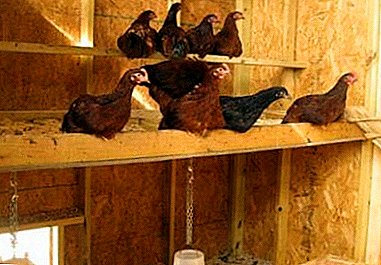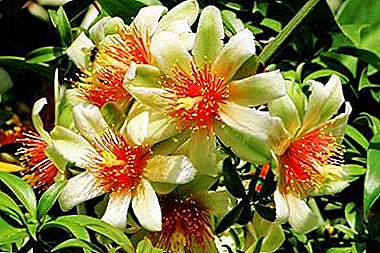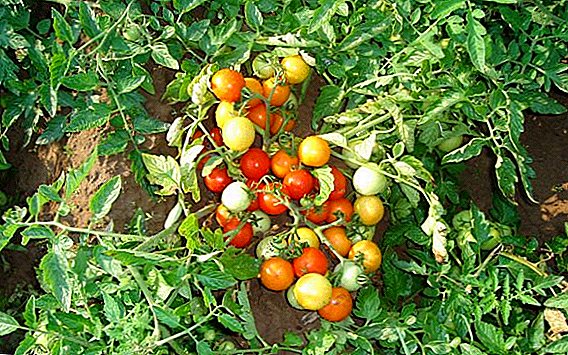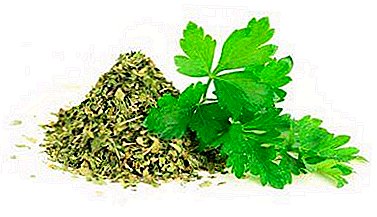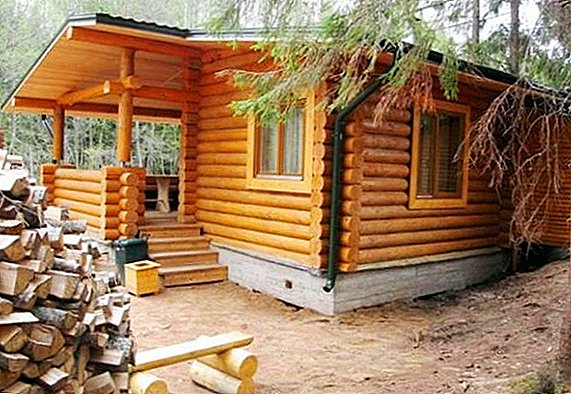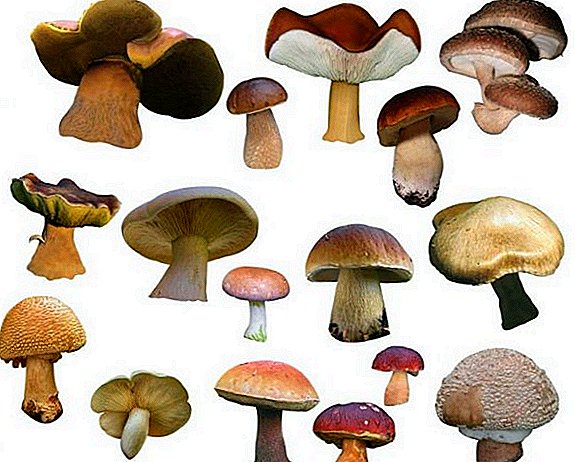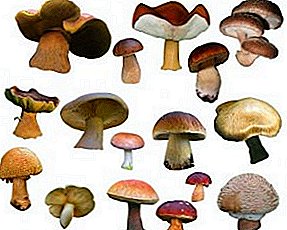 Due to the warm and pleasant climate, the Kaliningrad region has a rich, diverse flora and fauna. There are beautiful mountains, forests, steppes, reserves, there are various animals and many kinds of mushrooms grow. However, when collecting mushrooms, the so-called "quiet hunt", you need to take special care, because the climate favors not only edible varieties, but also those that are completely unsuitable for food. It is necessary to study in advance their characteristic features in order not to err afterwards.
Due to the warm and pleasant climate, the Kaliningrad region has a rich, diverse flora and fauna. There are beautiful mountains, forests, steppes, reserves, there are various animals and many kinds of mushrooms grow. However, when collecting mushrooms, the so-called "quiet hunt", you need to take special care, because the climate favors not only edible varieties, but also those that are completely unsuitable for food. It is necessary to study in advance their characteristic features in order not to err afterwards.
Edible Mushrooms
Mushroom season in the Kaliningrad region lasts more than six months, starting in April and ending with the last days of November. Here, mushrooms grow almost everywhere - they do not necessarily go into the woods, because a couple can be found even in their garden.
There are four main areas in this region where a special abundance of “forest gifts” is marked:
- The Neman lowland, which includes the Slavskoye timber industry, the Illichivsk and Polesskoe forest ranges. The region is characterized by the presence of podzolic, peaty, marsh and silt-marshy soils, on which black alder lives in large quantities.
- Baltic and Curonian forestry, which differ sandy soils. Together with constant winds from the sea, they form suitable conditions for the growth of fungi. In most cases, you can meet a pine. Birch and black alder grow in the lowlands, occasionally you can find oak, ash and hornbeam.
- Another region, especially favorable for the growth of fungi, are considered to be the plots of the Nesterovsky forestry and the Krasnoznamensk forestry, which are distinguished by a variety of relief. In Nesterovsky district dominated area with numerous hills. Pine grows well on stony soil. Spruce and deciduous forests thrive in loamy land.
- The remaining regions constitute the fourth zone, which is rich in spruce-birch forests. Here, hornbeam, ash and oak trees are most common, and black alder grows in the lowlands.
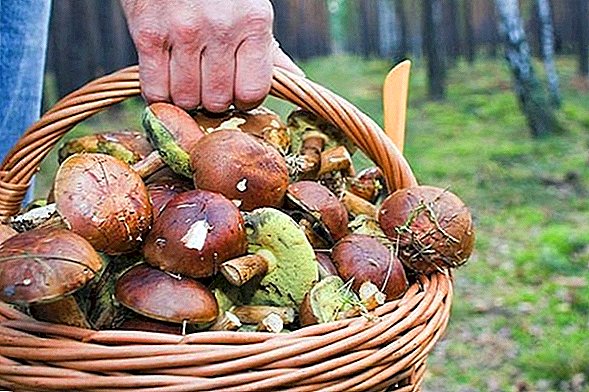
Mushrooms are divided into edible, conditionally edible and inedible, as well as poisonous. However, an inedible species is not always possible to get poisoned; At the same time, edible mushrooms, the rules of assembly, procurement or storage of which have been violated, can lead to health problems.
There is no clear difference between edible and poisonous species. Nevertheless, many poisonous species - for example, amanita - are difficult to confuse with others.
Did you know? In Italy it is forbidden to independently collect boletus in the forest. To "hunt" for the white fungus, you need to get a special permit from local authorities.
The most obvious sign of a toadstool and toadstools is the presence of a volvo, remnants of the outer shell, which at an early age covers the entire body, and then forms a "potty" from which the stem grows. Mushrooms suitable for use, differ spongy structure of the cap, but most of the inedible, it is lamellar. 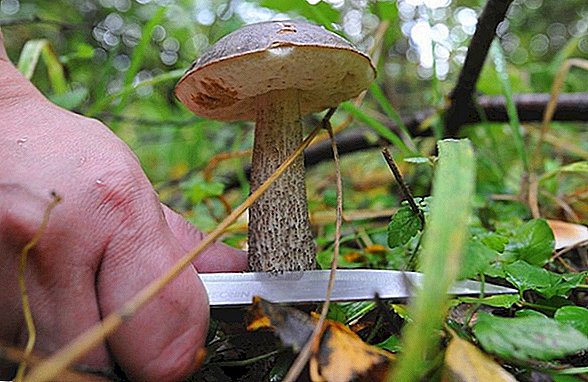
Important! Among the poisonous species, the spongy structure of the cap has exclusively a satanic mushroom, resembling a boletus. But to distinguish it from the boletus is quite simple - the poisonous mushroom has a whitish cap, not a brown one. In addition, the middle part of the leg is colored pink or red, and the flesh on the cut quickly turns blue.
In the Kaliningrad region you can find a huge number of mushrooms, both traditional and original. They are used for cooking soups, side dishes, appetizers, salads, sauces. Mushrooms fry, boil, stew, dry, pickle, make all kinds of preparations for the winter. Moreover, they are used in folk healing for the treatment and prevention of many ailments.
White mushroom
Cep, he is a boletus - one of the most beloved and popular among the people. He gained wide fame not only because of his noticeable, well-recognized appearance, but also because of his excellent taste. The boletus differs in rather large sizes: the cap is up to 25-30 cm in diameter, the leg is thick, the bottom is thickened.  The color of the cap will depend on the area where it grows. In birch forests, the hat has a light brown tint, in pine forests it acquires a purple tint, in spruce forests - a reddish brown. The flesh is firm, elastic, white, does not change its color when cut.
The color of the cap will depend on the area where it grows. In birch forests, the hat has a light brown tint, in pine forests it acquires a purple tint, in spruce forests - a reddish brown. The flesh is firm, elastic, white, does not change its color when cut.
Familiarize yourself with the types and beneficial properties of porcini mushrooms, as well as learn how to prepare porcini mushrooms for the winter.
The most comfortable habitat for white fungus are birch, pine forests and spruce forests.
Ordinary smooth
There are many mixed forests in the Kaliningrad region, which are favorable for smooth living. Their collection starts from the last month of summer to October. Smoothys can be recognized by the characteristic purple-gray color of the cap. With age, the rings on the cap disappear, and she becomes yellow-red. 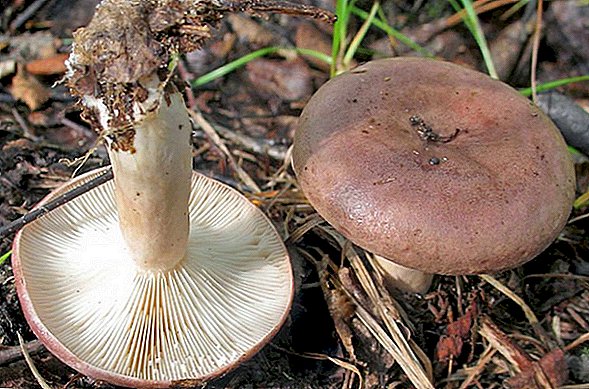 The leg is long and thin, thickened at the bottom or in the middle. The white flesh is fragile and fragile; when pressed, acrid juice is released, which turns yellow on contact with air. Smoothies are great for pickling. However, before this they need to soak in salted water and boil.
The leg is long and thin, thickened at the bottom or in the middle. The white flesh is fragile and fragile; when pressed, acrid juice is released, which turns yellow on contact with air. Smoothies are great for pickling. However, before this they need to soak in salted water and boil.
Milk whites are black
Milkworms are eagerly collected only in Russia - in the West they are classified as inedible. However, with proper cooking (especially salting), the milk mushrooms are not only edible, but also tasty. In the Kaliningrad region, they are found everywhere: in birch, pine, spruce forests, on glades, forest edges, etc.
We advise you to read about what types of milk mushrooms exist, how they are useful, as well as how to collect and harvest black, aspen milk mushrooms.
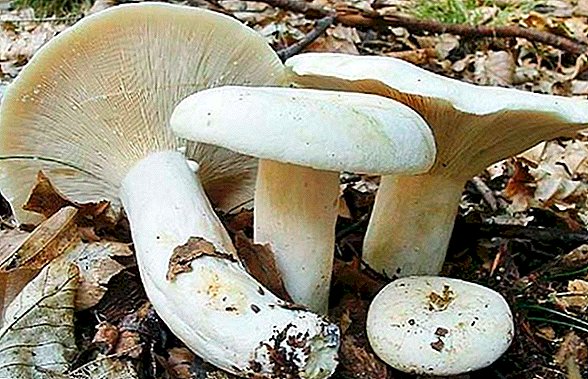 White milk mushrooms
White milk mushroomsThe main varieties of moorie are white and black.
- The distinctive feature of whites is a milky white, sometimes yellowish color of the cap with small specks and unique rings. Cap up to 8 cm in diameter. Mushrooms are short, dense, grow in groups. The pulp has a dense structure, when pressed, the milky juice is separated, which turns yellow in the air.
- Dark black or black is characteristic of black salmon. Sometimes they are also nicknamed chernushki. The leg is short, the cap has slightly curved edges, the plates are of a dirty green color. Favorite habitat Chernushkas - mixed forests. They can also be found in old foliage, mosses, under branches.
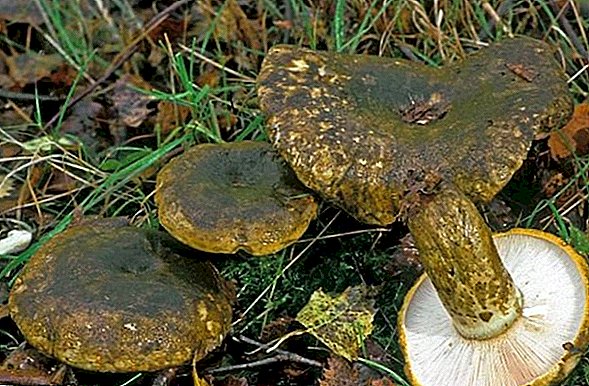 Black milk mushrooms are beautiful in saline form; so they can be stored without loss of taste for up to three years.
Black milk mushrooms are beautiful in saline form; so they can be stored without loss of taste for up to three years.Important! Before salting black milk mushrooms, they must be soaked for at least three days, then boiled.
Greenfinch
An excellent place for the growth of greenfinches is dry pine forests, where they are settled by whole families. They begin to collect at the end of the mushroom season in the fall. They got their name due to the yellow-green color of the cap - this color is retained even during heat treatment.
Zelenushka has a dense, slightly stiff pulp of white color, which soon turns into yellow. Under the cap are delicate plates of different colors. Zelenushki is recommended to boil, fry or pickle. The main thing - before any cooking they need to be peeled 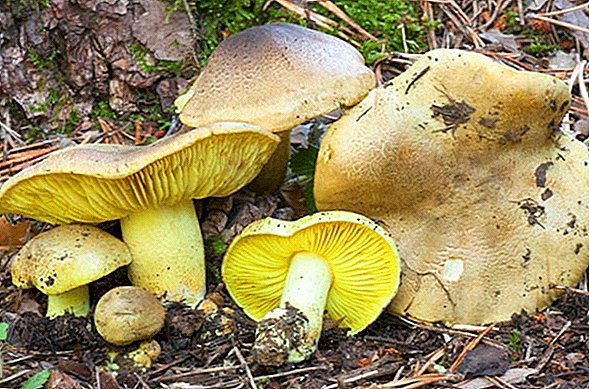
Goat
The goat is an ugly fungus, which at the same time has a rather pleasant taste. Cap with a diameter of 4-12 cm has a pale light brown color. In young representatives, it takes a rounded shape, later almost completely straightened, becoming flat.
Leg - thin, curved, of the same color as the cap. During rainy weather the goat is covered with a thick layer of mucus, which makes it look even more unpleasant. The flesh is quite dense and has a pleasant aroma.
Goats should be sought in swampy, wet places, in damp pine forests. In the food should use young mushrooms. They are recommended to fry, boil, pickle or dry. 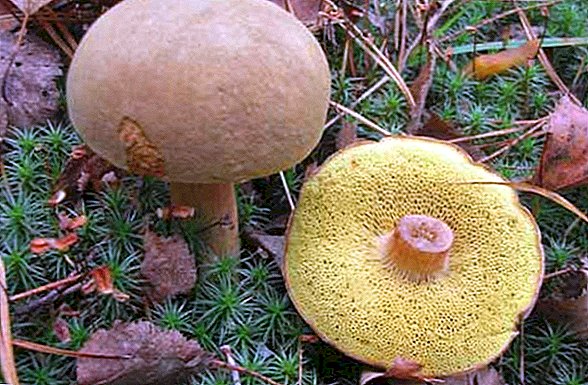
Chanterelle
Small, bright and beautiful chanterelles inhabit mixed, deciduous and pine forests, in glades with grass or moss. Because of their remarkable appearance, they are difficult to confuse with other types of mushrooms.
You will probably be interested in reading about where chanterelles grow and how not to get false mushrooms, how useful they are, and how to freeze and marinate chanterelles at home.
Chanterelles are characterized by a funnel-shaped, wavy cap, covered with fan-shaped plates below, and a thin leg up to 12 cm tall. They have a bright, yellow-orange color. The flesh is dense, juicy, keeps freshness for a long time and, in rare cases, is wormy.
Chanterelles taste similar to mushrooms and porcini mushrooms. They are tasty in any form: fried, boiled, stewed, pickled. Often they become a tool for the treatment of various diseases. 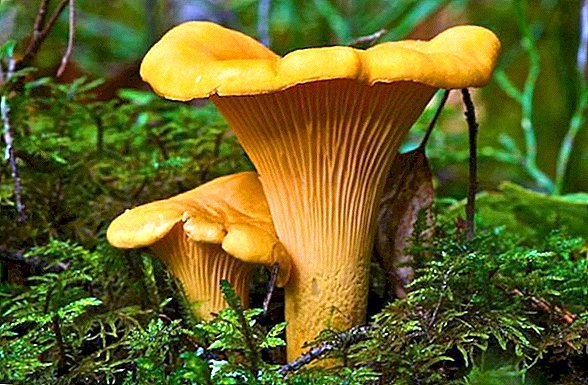
Maslata
Oil can be found almost everywhere: in forests, glades, edges, fields, paths, among the grass. The first harvest is collected by mushroom pickers during the flowering of the pine, the second - by the flowering of the linden. However, the maximum yield is manifested during the grain harvest period.
Maslata have a hat of different shades, depending on the habitat: from yellow and light brown to red-brown. Diameter 2-10 cm. The tubular layer, located under the head, is covered with a white film, which is subsequently converted into a ring. The flesh is tender, yellowish, has a pleasant aroma with notes of fruit.
Maslata are appreciated for their excellent taste, thanks to which they are widely used in cooking. They can be cooked and fried, pickled and pickled. Boiled butter stewed in milk has an especially savory taste. 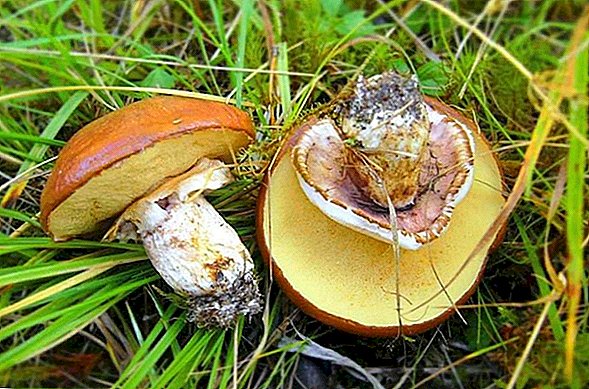
Mokhovik
In the CIS, 7 species of moth are common; Green and yellow-brown (chestnut) are most common in this area. Habitat habitat - sandy soil, coniferous forests, thickets of deciduous trees, edges, meadows.
- Green Moss it is distinguished by a large (3-12 cm), slightly convex hat of greenish or olive shades, which is covered with small scales from above. Leg straight, long, slightly expands upwards. The flesh is white.
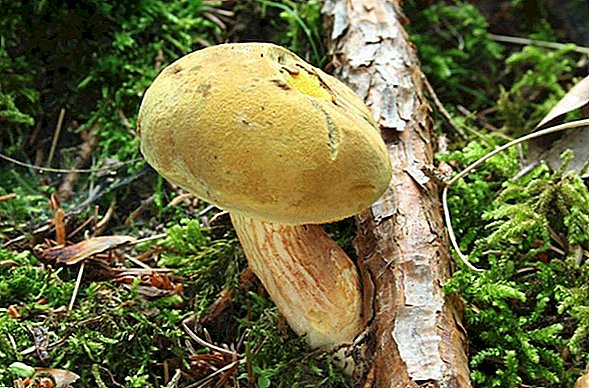
- Chestnut flywheel It has a dark brown, chocolate or brown color, a dense and fleshy bonnet with scales, a cylindrical leg of solid structure and a yellowish color. The flesh is yellow.

In both species, the flesh on the cut acquires a bluish tint, but this is not a sign of danger. It is noteworthy that poisonous mokhovikov or mushrooms similar to them do not exist. Mokhoviki have a pleasant taste, used for pickling, drying, salting. Perfectly heat-treated as frying, stewing or boiling.
Important! Collecting boletus, it is necessary to carefully monitor that the mushrooms were not covered with mold. It is dangerous to health.
Summer honeydew
The main advantage of the experience is that they grow in families, large groups. Summer mushrooms - or linden mushrooms, as they are also called - settle on rotted wood and trees.
Moth has a small size; the cap reaches 3-6 cm, has a convex shape with a tubercle in the middle, around which circles are visible in wet weather. The leg is thin, up to 7 cm long, in the upper part it is light, smooth, dotted with scales at the bottom. It is located ring in the form of a skirt, which can later disappear. 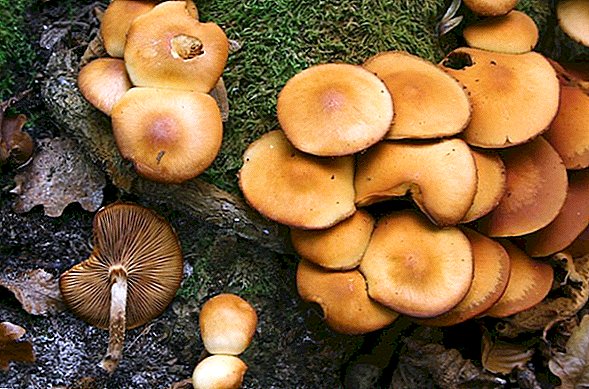
Autumn honeycomb
Autumn mushrooms larger in size. Their leg can reach 10 cm, and the cap at the girth is up to 17 cm. The hat has a convex shape, but becomes flat with age. Its base is covered with a layer of scales. Under the hat itself is a skirt, white in color with a yellow border.
Coloring of the honeycomb depends on the type of tree where he settled: the oak is brown, the poplar is yellow with honey, the pine is brown-red. 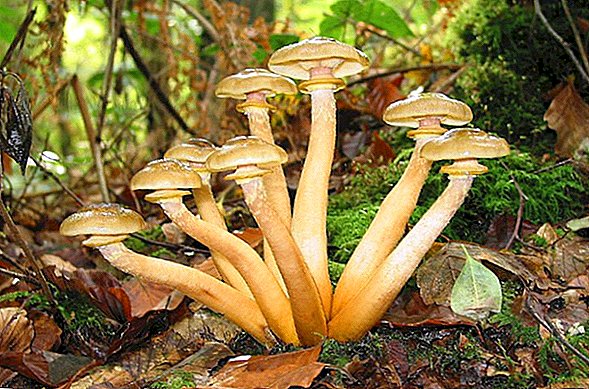
Learn more about edible mushrooms such as boletus, kids, boletus mushrooms, aspen mushrooms, greenfinch mushrooms, parsley, boletus mushrooms, mushrooms.
Boletus
During the flowering period of viburnum, during haymaking, mushroom pickers go in search of boletus that grows most in open areas, forest edges, field edges and in birch forests.
Boletus differs in rather large sizes: the cap can reach 15 cm, the leg is long, dense, covered with dark scales. There are mushrooms of white, yellow or brown color. Boletus mushrooms are ideal for pickling. They are dried, fried or boiled. 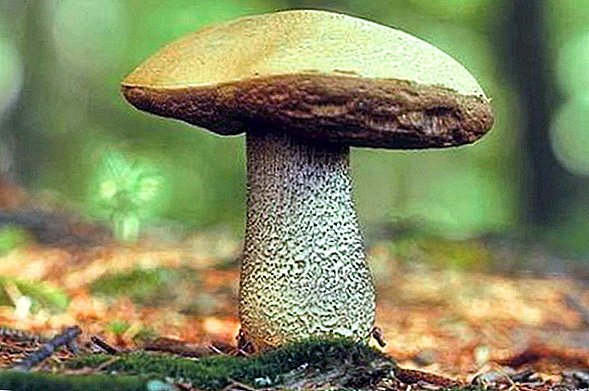
Boletus
It is not difficult to notice an orange-cap boletus in the woods. It is distinguished by a large round hat of orange, brown or white color, and also by a dense and long leg, thickened downwards, the surface of which is covered with scales. When cut, the flesh becomes blue. Aspen mushrooms prefer to settle in mixed, birch forests and blueberries.
Did you know? Many believe that the mushroom that “speaks” the name was obtained because of the place of growth, and also because of the color of the cap, which is similar in color to autumn leaves. However, it can be found not only under the aspens, but also on the forest edges, forest paths, glades.
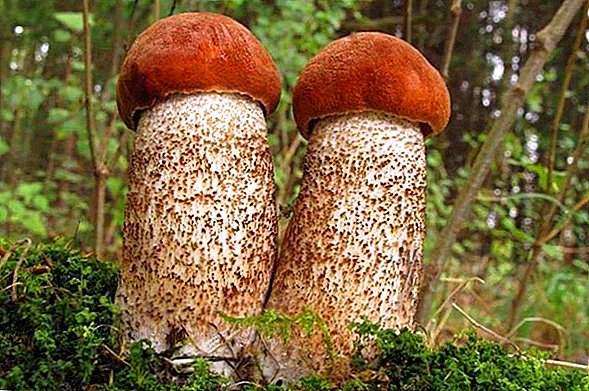
Aspen collection begins in July and ends with the first frost. These mushrooms are used for cooking soups, stews, they are added to vegetables. Also pickled and dried.
Mushroom growers will be interested to read about what edible mushrooms grow in the fall.
Polish mushroom
Chestnut mokhovik known in the Kaliningrad region under the name "Polish mushroom". The favorite place of its habitat are pine forests with a swamp, conifers, thickets of trees. It can also be found on sandy soils.
The Polish mushroom has a light brown, brown chestnut or dark brown color hat with a non-separating skin. After precipitation, the cap becomes sticky and slippery to the touch. The leg has a wrinkled surface of a yellow shade and dense structure. When cut, the flesh turns blue. 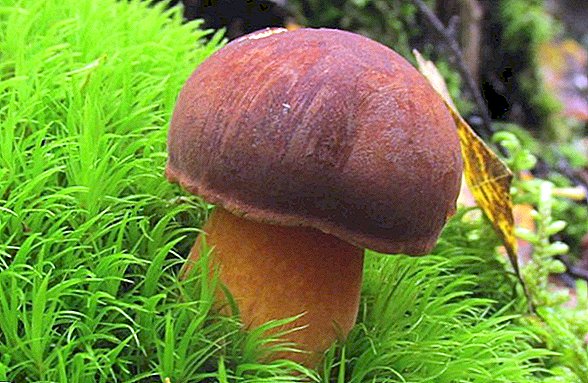 Since chestnut flywheel has a pleasant taste, it is suitable for any kind of processing: pickles, pickling, frying, etc.
Since chestnut flywheel has a pleasant taste, it is suitable for any kind of processing: pickles, pickling, frying, etc.
Redhead
Ryzhiki, although they do not have a remarkable "appearance", were loved by many mushroom pickers for their unique taste. Collect them on elevated sites among the pines and spruce trees, starting in mid-August. Ginger differs bright orange color and the presence of green blotches on the cap.
It will be useful for you to read about which mushrooms are edible and poisonous, and also to learn how to check the mushrooms for edibility by popular methods.The mushroom stem is also orange. The size of the cap varies from 4 to 17 cm, and in young representatives it is given upwards, and in older ones it becomes funnel-shaped with straight edges. Hogs are used for frying and stewing, but the best means is salting.
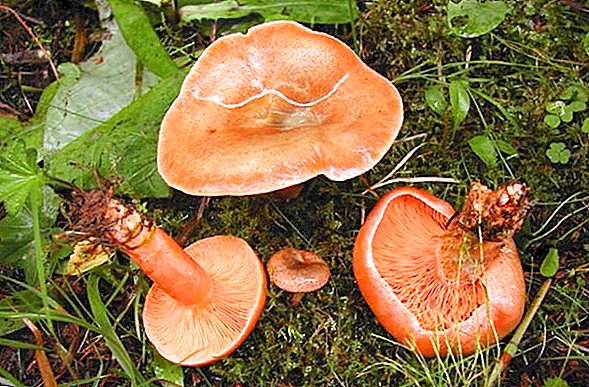
Toilet seat
The redbird or, as the locals called it, the plantain is a mushroom that grows in mixed and birch forests, along roads, on trails. Its distinctive features are: a tight, gray-purple hat 4-10 cm with rings, the same color as a thin leg, fleshy flesh, releasing milky sap when pressed.
Did you know? There are about 3000 species of cap mushrooms, among which only 400 are suitable for consumption.Cherry grows in groups, often their bodies partially grow together. This type is only suitable for salting. In addition, various medical pastes and ointments are made from it.

Russula
Russula were so named due to the fact that some of their varieties can be eaten raw. Mushrooms are distinguished by a variety of colors: their cap is able to acquire all the colors of the rainbow. But the leg is white and strong.
At an early age, the cap is convex, rounded, later becomes flat or even funnel-shaped. The pulp is dense, spongy, white at the cut. Russulae inhabit swampy areas in spruce-pine, deciduous forests. They grow in groups, do not hide in the grass or leaves, so they are easy to find even for inexperienced mushroom pickers.
However, they are not very popular because of their fragile structure. Some types of russules have a bitter, burning taste, so before cooking they must be soaked in cold water for two days. 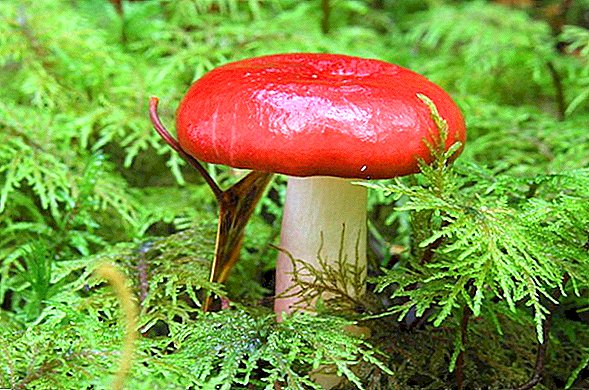
Inedible, poisonous mushrooms
The main danger of inedible and poisonous mushrooms is that they skillfully disguise themselves as certain types of edible. Therefore, in order not to become a victim of poisoning, one should learn to distinguish between edible and unfit varieties.
Death cap
Pale toadstool - the most dangerous among poisonous mushrooms. Its consumption ends in paralysis, and then death. A small fungus can be enough to poison four adults.
The configuration of the cap is hemisphere, but at an early age it has a more round, egg-shaped shape. The cap with a diameter of 5-15 cm, has an olive color (can vary from white to grayish), the surface is fibrous with smooth edges. Leg thin - about 2.5 cm, with a white scaly surface. 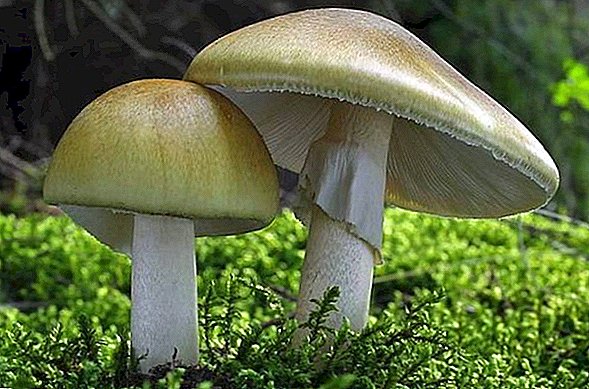
The flesh is friable, tender, white in color, with a neutral taste and a slightly sweet, but unpleasant smell. A distinctive feature of the toadstool is the presence of a wide volva at the base of the leg.
Important! The main danger of the toadstool is that the person becomes ill only after the poisons began to act. A person is faced with gastrointestinal problems, muscle pain, diarrhea, pressure reduction. After some time, the patient's condition may improve, but this is just a false calm, during which the kidneys and liver are destroyed.
Gall mushroom
Чаще всего желчный гриб встречается в хвойных и лиственных лесах, на кислых, плодородных почвах. Внешне он напоминает белый гриб, однако его можно легко распознать по уникальному сетчатому рисунку, расположенному на ножке. 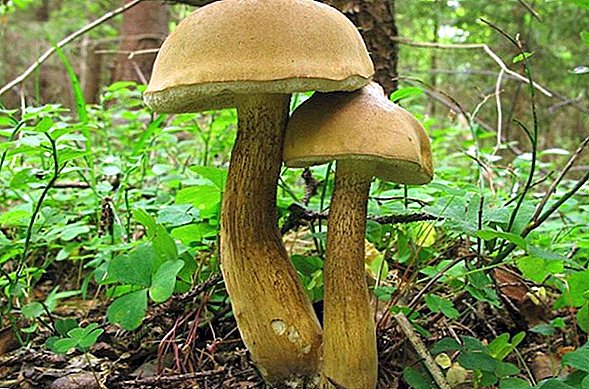 The cap has a hemispherical shape, can reach sizes from 4 to 15 cm; its surface is dry, slightly velvety, in wet weather it becomes sticky. The color of the cap is different: from yellow-brown to dark brown. The leg is tall and thin, cylindrical, swollen downwards.
The cap has a hemispherical shape, can reach sizes from 4 to 15 cm; its surface is dry, slightly velvety, in wet weather it becomes sticky. The color of the cap is different: from yellow-brown to dark brown. The leg is tall and thin, cylindrical, swollen downwards.
The flesh is white, with a cut pink, has an unpleasant bitter taste, is not wormy and does not have a pronounced smell. Symptoms of poisoning by this organism are similar to eating a toadstool or satanic fungus. In the elderly, 85% of cases of poisoning end in death.
Amanita red
Amanita - the most colorful representative of poisonous mushrooms, which is difficult to confuse with others. Its bright red hemispherical cap has a characteristic white spot. Leg dense, short and rather thick. The fly agaric grows mainly on acidic soils, in mixed forests. 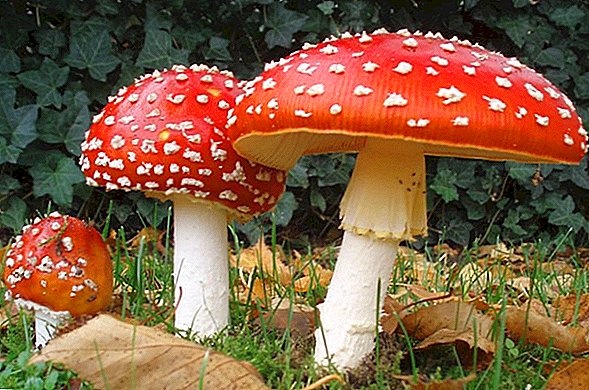 In most cases, the use of red mushroom does not cause death, but leads to the appearance of hallucinations, loss of hearing and vision. In small quantities extracts from the fungus are used in medicine for the production of drugs that have anti-inflammatory, anti-cancer effect.
In most cases, the use of red mushroom does not cause death, but leads to the appearance of hallucinations, loss of hearing and vision. In small quantities extracts from the fungus are used in medicine for the production of drugs that have anti-inflammatory, anti-cancer effect.
We recommend to read about how different types of toadstools look like, as well as useful properties of fly-agarics.
Amanita mushroom
Less vivid, but no less poisonous, is the close relative of the red mushroom - the mushroom mushroom. Its distinctive characteristics are considered to be a pale yellow lemon color and a thick, clean, spherical at first, and then a flat cap, covered with large whitish flakes on top. 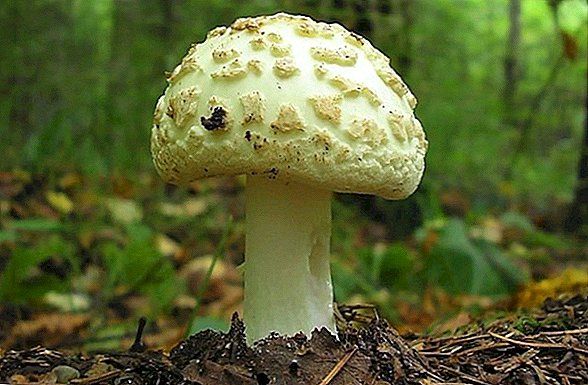 The stem is rather long, up to 12 cm, of a cylindrical shape, thickened at the end with grooves above the ring. The flesh is soft, loose, with the aroma of potatoes and a bitter, unpleasant taste.
The stem is rather long, up to 12 cm, of a cylindrical shape, thickened at the end with grooves above the ring. The flesh is soft, loose, with the aroma of potatoes and a bitter, unpleasant taste.
Symptoms of a fungal mushroom poisoning are similar to red poisoning: shortness of breath, nausea, vomiting occurs, and convulsions, hallucinations, and loss of consciousness can develop with strong concentrations of poison.
We recommend that you familiarize yourself with the description of such inedible fungi, such as dung beetles, false boletus, satanic mushroom, gall fungus, pedal toadstool.
Satanic mushroom
Satanic mushroom looks similar to white. It can be found in mixed and deciduous forests in areas with calcareous soil. It is rather large in size: the cap reaches 8–20 cm, the leg is up to 15 cm high, and the width is up to 10 cm. 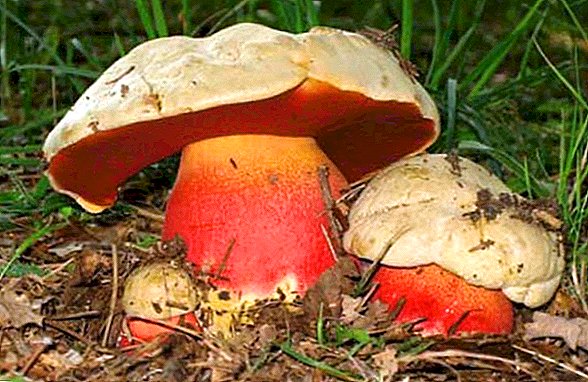 Cap colors range from pale gray to lead gray. Leg swollen, has the shape of a tuber. The flesh is distinguished by a yellowish tinge; at the cut, it acquires a moderately blue color.
Cap colors range from pale gray to lead gray. Leg swollen, has the shape of a tuber. The flesh is distinguished by a yellowish tinge; at the cut, it acquires a moderately blue color.
The difference between the satanic fungus and white is the presence on the leg of a characteristic grid of olive or red color. Also from the fungus is an unpleasant odor. Satanic fungus, when consumed, provokes disorders of the nervous system, affects the liver and spleen.
Champignon false
A distinctive feature of the false champignon is a persistent iodized odor or aroma of carbolic acid. The cap is white, has a smooth base with small scales. The flesh is white, but when pressed yellow. False white mushroom stem, thickened at base.
When cut, the leg flesh turns yellow, gradually turns orange, and then brown. When cooking false champignons, their peculiar smell increases, and the water turns yellow.
Important! Even with long cooking, the poison from the fungus does not go away. After only two hours after eating the false champignon, there are bright signs of poisoning: vomiting, nausea, diarrhea.
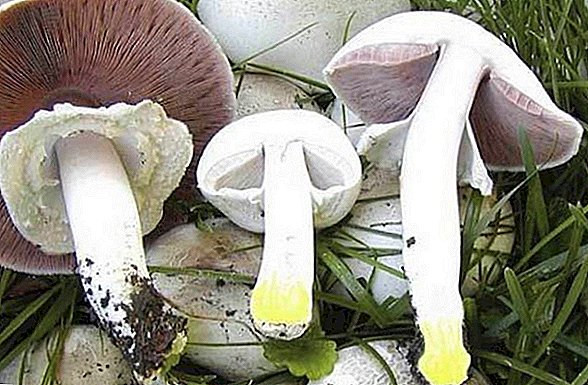
Mushroom places of the Kaliningrad region
The "Mushroom Hunt" in the Kaliningrad region starts from April and ends with the first frosts.
To campaign for mushrooms was successful, you should know the "mushroom places":
- mushrooms most often can be found in the territories of the Curonian and Baltic forest enterprises, near the town of Nesterov, in the northeast region of the region, the Novoderevensky forest, Bolshie Gorki, the Bolshakovsky forest;
- favorite places chanterelles are the seaside and neighborhood of Povarovka;
- Zelenushkas mushroom pickers search around the dunes on the Curonian Spit;
- in search of muzzle you can go to the Baltic braid, Kumachevo, Kruglovo, visit the south-western regions - Ladushkinsky forest, Chertov Most, Ushakovo;
- fulfill the dream of mushroom pickers and find a large clearing borovikov, you can go to the village Kosmodemyanskaya, Big Village, in the Soviet forest range; The surroundings of the Vyshtynetsky lake are also considered a good area for white mushrooms.
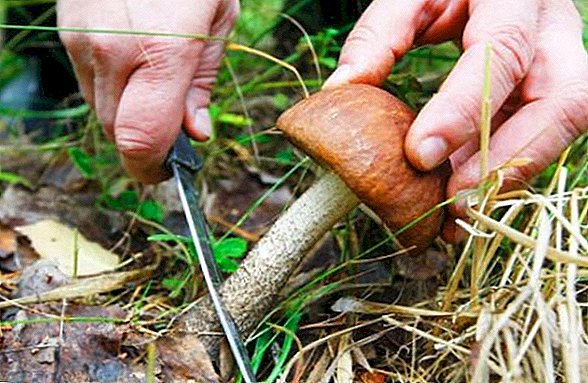 It should be remembered that without exception, all types of fungi choose acceptable conditions for growth. If the forests are dark, then mushrooms should be looked for on light glades, on forest edges, near roads; If there is a lot of lighting, you should direct the search for darkened areas. With excessive humidity, the mushrooms will migrate to elevated areas, and if it is lacking, they will hide in ravines.
It should be remembered that without exception, all types of fungi choose acceptable conditions for growth. If the forests are dark, then mushrooms should be looked for on light glades, on forest edges, near roads; If there is a lot of lighting, you should direct the search for darkened areas. With excessive humidity, the mushrooms will migrate to elevated areas, and if it is lacking, they will hide in ravines.Mushroom picking rules
Sometimes even edible mushrooms can become not harmless. And the whole thing here is in toxic substances - these organisms are able to absorb them like a sponge.
Therefore, going on a "quiet hunt, you need to follow some rules:
- The "golden rule" of mushroom pickers is to collect only familiar mushrooms. If there is even the slightest doubt about the origin and type of fungi - and even more so if there are tuber-like thickenings at the base of the mushroom stem - it is better to discard them immediately. Unfamiliar mushrooms can not be touched and even more tasted.
- Collect only healthy, young mushrooms. Do not put yourself at risk, paying attention to the wormy, dry, flabby, rotten mushrooms, which, at least, have lost their taste and useful substances.
- Do not disturb the mycelium. When collecting it is very important not to damage the mycelium, which will serve as the birth of a new crop. It is recommended that tubular-shaped mushrooms simply be “twisted” from the soil, and marsupials should be cut with a sharp knife at the base.
- Collect mushrooms in environmentally friendly places. It is not necessary to "hunt" near the road, factories, in the industrial zone. It is better to visit the forest or go to the mountains.
- Put the mushrooms in baskets. For the collection of ideal packaging from materials of natural origin: wooden lubyanka, wicker box boxes. No need to take cellophane bags, in which the mushrooms will simply "steam".
- The best time for a "quiet hunt" are the morning hours. Mushrooms grow at night, so that in the morning they will be fresh, dense and persistent in transit.
- Extra time is considered the search for "prey" in the tall grass and thick windbreaks. The maximum that can be hoped for is a few pieces per hour.
- Immediately after coming home, the “trophies” found should be cleared, as they quickly lose their properties. Peeled mushrooms are boiled without fail.
Important! It is strictly forbidden to use mushroom broth, even if it was preparing familiar varieties of all.
Kaliningrad region is rich in various types of mushrooms, which mushroom pickers gladly stock up from early spring to late autumn. But, going on a "silent hunt" for tasty, fragrant and extremely useful trophies, we must not forget about the existence of poisonous species.
Just follow the main rules of collection and use - and then the process of preparation will be not only exciting, but also safe for health.
Reviews from the network








